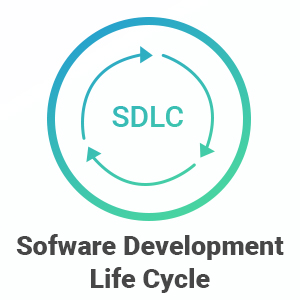


Software Development Life Cycle (SDLC) is a process used by the software industry to design, develop and test high quality software. The SDLC aims to produce a high-quality software that meets or exceeds customer expectations, reaches completion within times and cost estimates.
SDLC is a process followed for a software project, within a software organization. It consists of a detailed plan describing how to develop, maintain, replace and alter or enhance specific software. The life cycle defines a methodology for improving the quality of software and the overall development process.
The following figure is a graphical representation of the various stages of a typical SDLC.
Requirement analysis is the most important and fundamental stage in SDLC. It is performed by the senior members of the team with inputs from the customer, the sales department, market surveys and domain experts in the industry. This information is then used to plan the basic project approach and to conduct product feasibility study in the economical, operational and technical areas.
Planning for the quality assurance requirements and identification of the risks associated with the project is also done in the planning stage. The outcome of the technical feasibility study is to define the various technical approaches that can be followed to implement the project successfully with minimum risks.
Once the requirement analysis is done the next step is to clearly define and document the product requirements and get them approved from the customer or the market analysts. This is done through an SRS (Software Requirement Specification) document which consists of all the product requirements to be designed and developed during the project life cycle.
SRS is the reference for product architects to come out with the best architecture for the product to be developed. Based on the requirements specified in SRS, usually more than one design approach for the product architecture is proposed and documented in a DDS – Design Document Specification.
In this stage of SDLC the actual development starts, and the product is built. The programming code is generated as per DDS during this stage. If the design is performed in a detailed and organized manner, code generation can be accomplished without much hassle.
This stage is usually a subset of all the stages as in the modern SDLC models, the testing activities are mostly involved in all the stages of SDLC. However, this stage refers to the testing only stage of the product where product defects are reported, tracked, fixed and retested, until the product reaches the quality standards defined in the SRS.
Once the product is tested and ready to be deployed it is released formally in the appropriate market. Sometimes product deployment happens in stages as per the business strategy of that organization. The product may first be released in a limited segment and tested in the real business environment (UAT- User acceptance testing).
Then based on the feedback, the product may be released as it is or with suggested enhancements in the targeting market segment. After the product is released in the market, its maintenance is done for the existing customer base.
There are various software development life cycle models defined and designed which are followed during the software development process. These models are also referred as Software Development Process Models”. Each process model follows a Series of steps unique to its type to ensure success in the process of software development.
Following are the most important and popular SDLC models followed in the industry −
The Waterfall model is the earliest SDLC approach that was used for software development. Waterfall Model illustrates the software development process in a linear sequential flow. This means that any phase in the development process begins only if the previous phase is complete. In this waterfall model, the phases do not overlap.
Iterative process starts with a simple implementation of a subset of the software requirements and iteratively enhances the evolving versions until the full system is implemented. At each iteration, design modifications are made, and new functional capabilities are added. The basic idea behind this method is to develop a system through repeated cycles (iterative) and in smaller portions at a time (incremental).
The spiral model is a risk-driven process model. This SDLC model helps the team to adopt elements of one or more process models like a waterfall, incremental, waterfall, etc.
This model adopts the best features of the prototyping model and the waterfall model. The spiral methodology is a combination of rapid prototyping and concurrency in design and development activities.
In this type of SDLC model testing and the development, the phase is planned in parallel. So, there are verification phases on the side and the validation phase on the other side. V-Model joins by Coding phase.
Agile methodology is a practice which promotes continue interaction of development and testing during the SDLC process of any project. In the Agile method, the entire project is divided into small incremental builds. All these builds are provided in iterations, and each iteration lasts from one to three weeks.
Rapid application development is a software development methodology that uses minimal planning in favour of rapid prototyping. A prototype is a working model that is functionally equivalent to a component of the product.